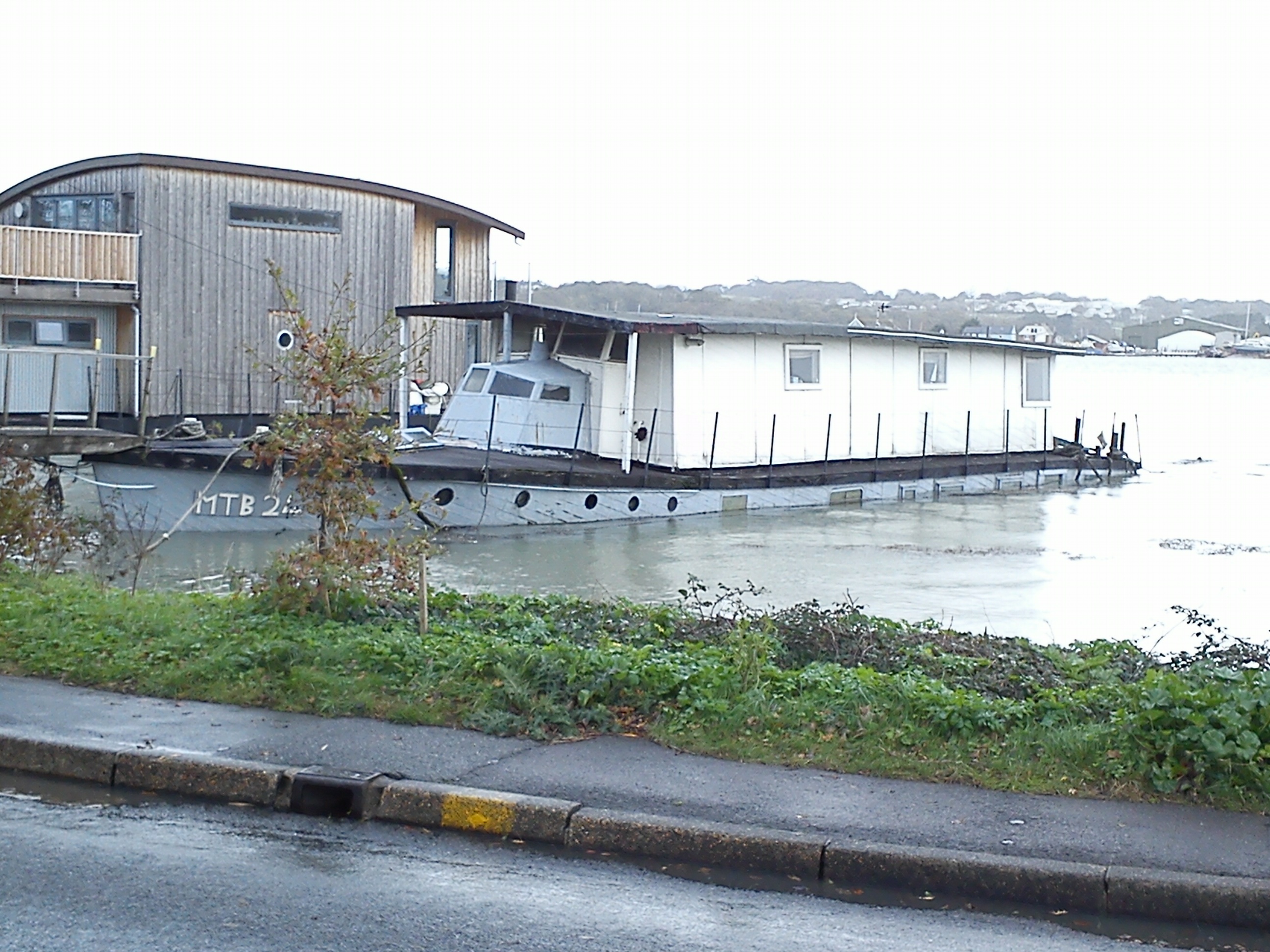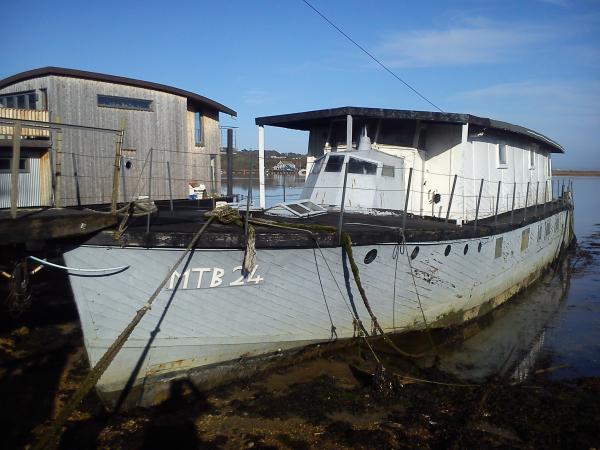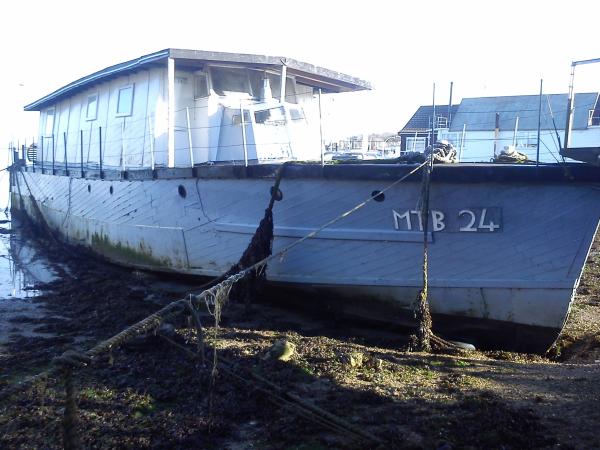
Details
Construction
Dimensions
History
MTB 24 was built by Thornycroft of Hampton on Thames in 1939, one of six Motor Torpedo Boats ordered on 15 August 1938, split between Vosper, Portsmouth & Thornycroft, Hampton.
The boat's length was 71ft 9ins, the beam was 16ft 6ins, the draught was 2ft 3ins (fwd)/ 4ft 4ins (aft), its displacement was 37 tons & it was powered by three Isotta-Franchini 1150/1200hp petrol engines, achieving a speed of 40 knots. It was armed with four 0.5"/62(12.7mm) Vickers Mk III Machine Guns, two 21" Mk XV Torpedoes & designed to carry eight Mk VII Depth Charges or four mines. MTB 024 was commissioned on 19 December 1939 & assigned to the 4th MTB Flotilla based at Portsmouth with a crew of two officers & eight other ranks.
During World War II MTB 024 took part in various operations around the coast of Britain and across the Channel. Notable operations include:
On 29 January 1940 the Flotilla moved base from HMS Vernon, Portsmouth, to HMS Hornet, Gosport, and from there to the Humber, arriving on 4 February with the destroyers EXPRESS, IVANHOE, INTREPID, ESK after Minelaying Operation JB in the North Sea.
On 22 April 1940 the Flotilla took part in Operation Shellfish; to intercept U-boats and German surface warships through the use of telegraph cables as navigation aids.
On 12 May 1940 the Flotilla departed Felixstowe for IJmuiden in the Netherlands to prevent the passage of enemy troops to the west by sea & to carry out a reconnaissance. The following day they were tasked to carry out a reconnaissance of the North Sea Canal towards Amsterdam for a group of destroyers waiting off Ijmuiden to evacuate personnel from Amsterdam. After reaching Amsterdam, the boats were attacked by enemy aircraft as they moored near the town of Enkhuizen, covering the boats with camouflage netting & wait for orders. On 14 May the Flotilla approached a lock and found that the Dutch army was still in control although Germans were overrunning Amsterdam. Along the canal, fuel tanks were ablaze & at 20.00hrs, on receiving intelligence that the enemy was now attacking the canal, the boats retraced their steps to Ijmuiden & were attacked by two German seaplanes. On 15 May the Flotilla were en route for Felixstowe when a group of the enemy attacked them & Able Stanley Aldridge, Gunner on MTB 24, shot down a Heinkel 115 torpedo bomber seaplane, the first enemy aircraft to be shot down by a Coastal Forces boat in WW2. During this attack, the gunners on MTBs 022 & 025 also hit & damaged a Dornier Do 18 flying boat. In July 1940, MTB 024 Able Seaman Aldridge was Mentioned in Dispatches for his service off the Dutch coast.
From 27 May to 4 June 1940, MTBs 024 & 022 together with boats from the 1st MASB Flotilla, 2nd MASB Flotilla, 1st MTB Flotilla, 3rd MTB Flotilla, 10th MTB Flotilla & 1st ML Flotilla, participated in Operation Dynamo. On day one, the MASB were deployed as tugs in Dunkirk Harbour, the 4th MTB Flotilla & 1st ML Flotilla were deployed ferrying troops from the beaches to large ships & the rest of the MTBs were deployed approximately two miles of the Dunkirk coast to screen the ships & boats evacuating the troops. However, during this period, these boats undertook various roles, including picking up troops from the beaches, guiding ships to beaches, acting as tugs, guarding convoy routes X, Y & Z (Dover/Ramsgate – Dunkirk), messenger duties, etc.
MTBs 024, 025, 028, 100, 102 & MGBs 058, 059, 060, 062, 063, 064 (6th MGB Flotilla) on 7 March 1941 were berthed at HMS Hornet, Gosport when a cry of fire was heard from MTB 028. MTB 028 was ablaze from stem to stern & out of control, as the crew were seen jumping into the water. All the MGBs & MTBs managed to get out of HMS Hornet before MTB 028 exploded with large pieces of metal from MTB 028 landed half a mile away in Gunboat Yard.
In 1941, MTB 024 was adopted by the village of Rainford, Lancashire; this was one of the 194 Light Coastal Forces boats to be adopted & sponsored by villages, towns, cities or specific areas in Britain. The money raised by public donations through this adoption programme, ‘Fund a Warship’, went to the Royal Navy to help fund the building of Royal Navy warships.
In 1942, MTBs 024, 025, 042, 045 (5th MTB Flotilla) in 1942 were re-engined with 3 x Sterling Admiral 1120bhp Petrol Engines.
On 3 March 1943, MTBs 024, 035, 038 with MGBs 110, 113, 114 intercepted a convoy escorted the 18th Patrol Boat Flotilla off Gravelines, Northern France. The MTBs attacked the merchant ships while the MGBs engaged the escort. MTB 024 was slightly damaged from shellfire.
On 10 April 1943, MTBs 024, 038, 219 with SGB 306 & MGBs 114, 117 on 10 April 1943 were off Berck Sur Mer when they intercepted two armed trawlers & four R-boats. After a brief firefight, they retired westward & were fired on by shore batteries.
On 28 December 1943, MTB 024 TLt Clarkson was awarded the Distinguished Service Cross, CMtMech Fox was awarded the Distinguished Service Medal & Leading Seamen Anderson was Mentioned in Dispatches.
On 12 April 1944, MTB 024 was part of the escort for convoy CF 259 when the convoy was attacked. During this action, the destroyer HMS SOUTHDOWN mistakenly opened fire on the convoy escort boat MTB 024, causing damage to the boat.
On 28 April 1944, MTB 024 was one of the vessels placed under the command of Dover Command & Vice Admiral Henry Pridham-Wippell as part of Operation Neptune (Invasion of Normandy) which was planned to take place in early June 1944. This would be the initial assault stage of the broader Operation Overlord & the liberation of Northwest Europe.
In 1944, MTB 024 was rearmed with 1 x 2 & 1 x 1 20mm/70(0.79") Oerlikon Mk II Cannon + 1 x 2 .5"/62(12.7mm) Vickers Mk III MG.
On 22 July 1944, MTBs 024, 353, 362 (5th MTB Flotilla) were dispatched to intercept enemy shipping near Boulogne. MTB 362 fired two torpedoes at a range of 1200 yards & missed. MTB 024 torpedoes misfired & MTB 353 was unable to get a target.
From October 1944, MTB 024 was transferred to the Reserve Fleet, initially based at Dover, then Dartmouth, and finally Poole. In October 1945, MTB 024 was placed on the disposal list.
We are lacking information about this particular vessel. If you have any information about this vessel, past or present, please contact us.
Key dates
-
1939
Vessel built by Thornycroft, Hampton on Thames
Own this vessel?
If you are the owner of this vessel and would like to provide more details or updated information, please contact info@nationalhistoricships.org.uk



